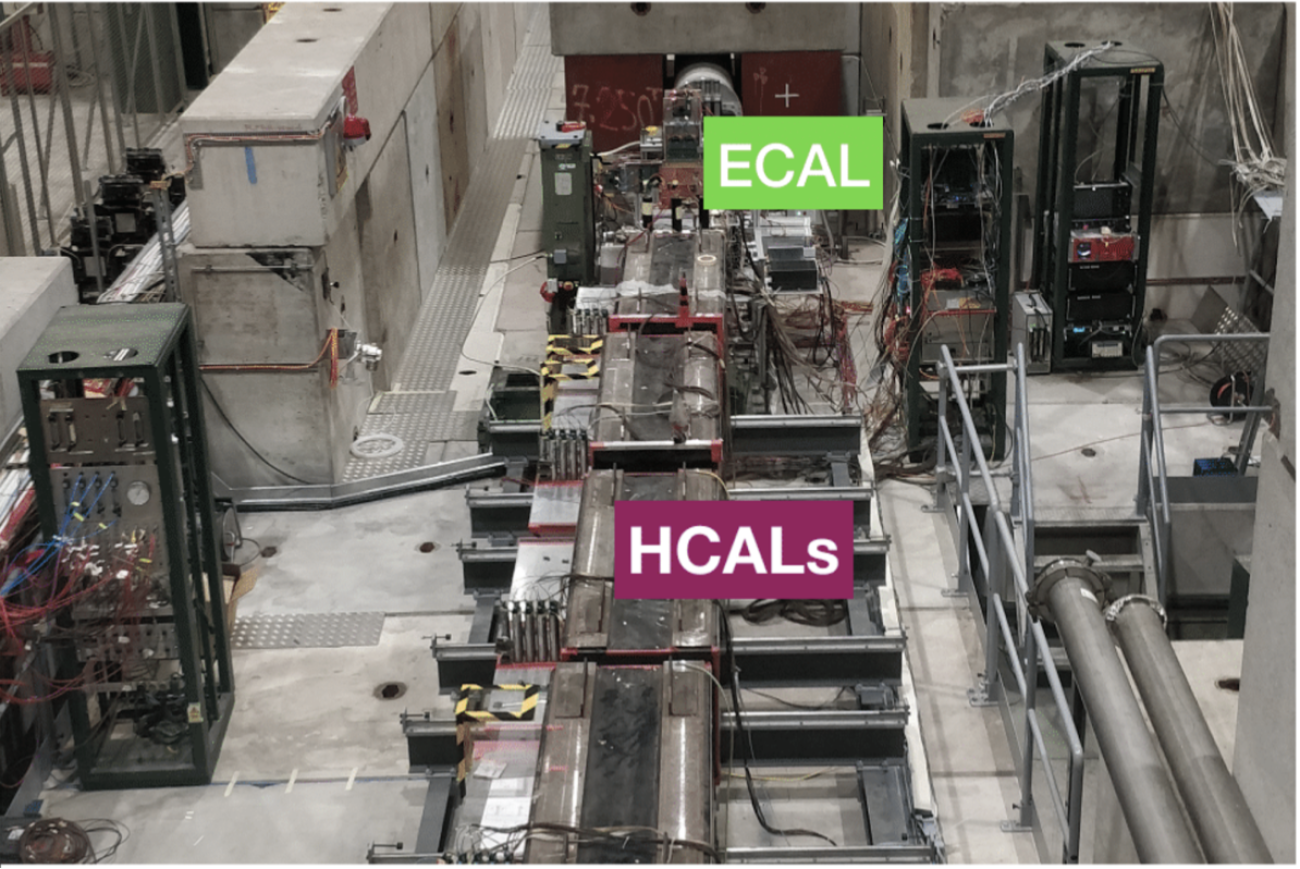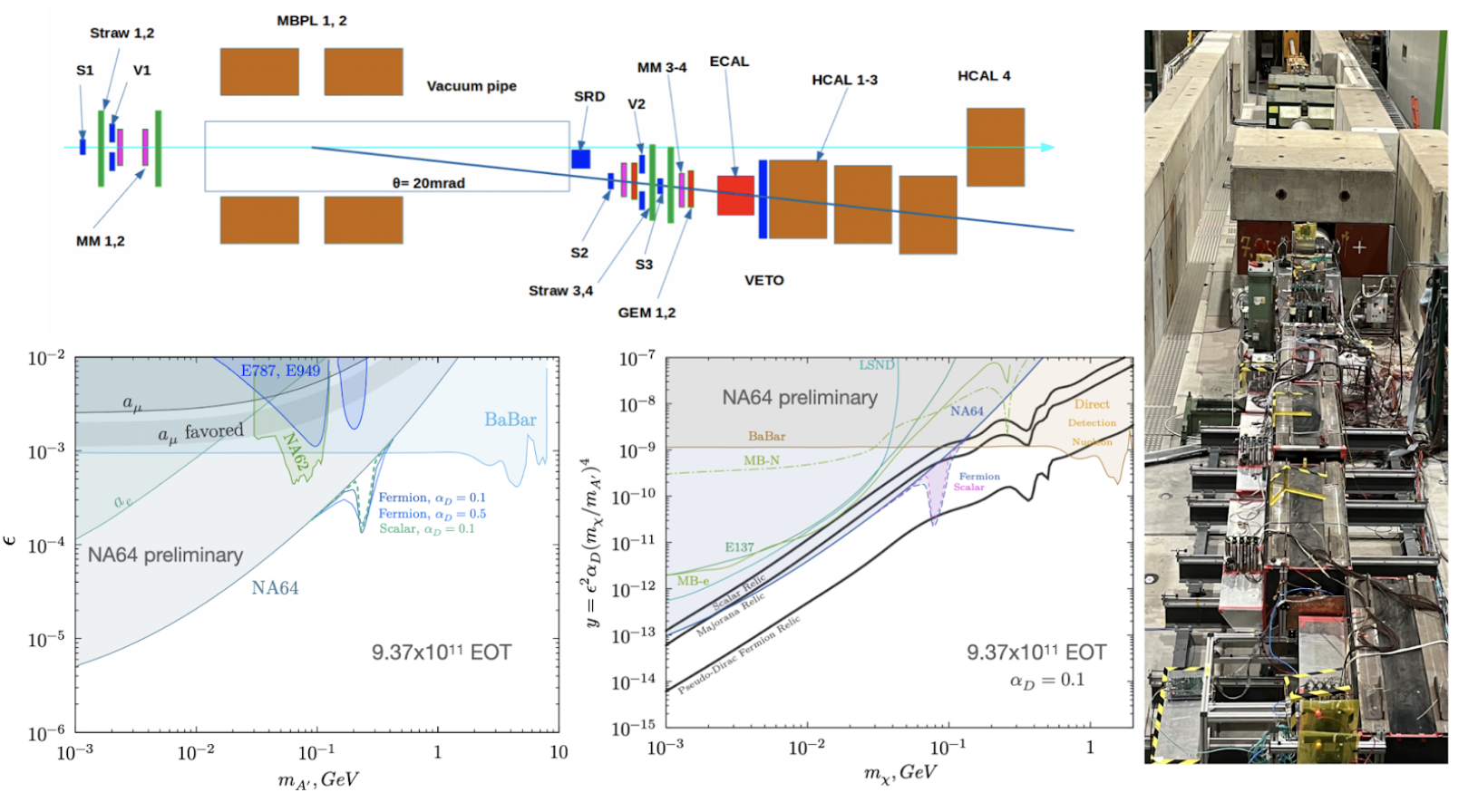Lighting the dark with NA64: news from Light Dark Matter searches

The existence of Dark Matter (DM) has been inferred by Cosmology and Astrophysics through its gravitational effects. However, its microscopic nature remains one of the most pressing questions in particle physics. Scenarios in which the DM is a thermal relic from the early universe are well-motivated as they allow us to connect the cosmological observations with the Standard Matter (SM) and DM interaction. In particular, in the thermal freeze out case one can relate the observed DM relic with the SM-DM annihilation cross-section. The DM candidates in this case can cover a broad mass range, being the Weakly Interacting Massive Particle (WIMP) (1GeV -10TeV) the most popular as the interaction is governed by the weak force. Nevertheless, despite the intensive searches in the last decades, the lack of evidence of DM in direct detection experiments and the absence of New Physics (NP) at the Large Hadron Collider has motivated searches at lower energy scales.
Scenarios which suggest the presence of a dark or “hidden” sector (DS) feebly interacting with the visible sector can also provide complementary WIMP-like DM candidates, in a broader and lower (sub-GeV) mass range (the so called Light Dark Matter (LDM) models) [1-3]. These models are simple and predictive as the thermal freeze-out condition defines the interaction between the DM-SM providing an explicit target for experiments. Besides DM, sub-GeV hidden sectors are also motivated as NP extensions to accommodate fundamental puzzles as the origin of the neutrino masses; the observed low energy experimental anomalies such as the muon g-2 or X17; or axion and axion-like particles as solution to the strong CP problem [3-6]. Different types of particles can intertwine these sectors via portals governed by SM symmetries, covering a wide range of masses and decay modes. This fact has boosted a worldwide theoretical and experimental effort yielding a plethora of new experimental avenues. The CERN initiative Feebly Interacting Particles (FIPs) [4], built inside Physics Beyond Colliders (PBC) [5], is one of the main drivers of this new paradigm aiming to coordinate the scientific program involving these phenomena. As a matter of fact, the 2020 European Strategy for Particle Physics update recommended to support searches for DS candidates, as well as the latest US community study on the future of particle physics, Snowmass 2021 [6].
One of the preferred candidates to mediate the interaction between the two sectors is the dark photon, A’. In this case, the addition of a new gauge symmetry, U(1)D results in a new massive vector boson which couples to DM with eD (in analogy to Quantum electrodynamics one can define αD=e2D/4π). This new particle mixes kinetically with the 𝛾 or the Z boson via the vector portal εF𝜇𝜈F’𝜇𝜈. Depending on its mass, A’ could decay to SM particles or to light dark states, 𝝌. In particular, if these dark mediators correspond to the lightest state in the dark sector, then they would decay mainly visibly, i.e., typically to SM leptons such as electrons or muons, or hadrons, which could be used to detect it. Such particles of few GeV masses have already stringent constraints coming from beam dump, fixed target, collider, and rare meson decay experiments. Nevertheless, in the presence of light dark states with mass below mA´/2, the dark boson would predominantly decay invisibly. In this case, the experimental constraints are weaker, leaving an interesting unexplored area and with present and future experiments devoted to searching them [3-6]. In addition, the requirement of the thermal freeze-out of DM annihilation into visible matter through γ − A′ kinetic mixing with strength eε, allows to establish a connection between the observed relic DM density and the predicted DM-SM interaction. As a result, a well-motivated parameter space accessible by accelerator-based experiments and in particular by CERN Super Proton Synchrotron (SPS) energies can be defined using the dimensionless variable y = ε2αD(m𝝌/mA’)4. Taking into account CMB constraints and DM-SM via s-channel, three types of DM candidates can be defined: scalar, Majorana and pseudo-Dirac (black lines of the central plot of Fig. 1).
NA64 experiment searches for DS at CERN SPS after the collisions of a high energy electron, positron and muon with a target (see more details in previous EP Newsletter and in the CERN EP seminar). The experiment started taking data using the 100 GeV electron beam at H4 beam line in 2016. The NA64 main physics target is the parameter space suggested by LDM models defined by mixing strengths 10−6 < ε < 10−3 and masses mA′ in the sub-GeV range. To that end, NA64 pioneered the active beam dump technique in which the A´ is directly produced in the electron-interactions with a target (an electromagnetic calorimeter (ECAL)) via Bremsstrahlung and could decay subsequently to a pair of LDM candidate particles leaving missing energy as signature. For this reason, we call these searches “invisible”. In this case the signal yield scales as ε2, enhancing the sensitivity with respect to the ε4αD yield from the traditional beam-dump approach (here the A’ is produced in the beam dump and its posterior decay is measured in a detector). The results using the 2016-2018 statistics set the strongest limits in LDM models for masses below 200 MeV [7]. Lately, the resonant A′ production channel through the e--annihilation with the positrons present in the electromagnetic shower has been also exploited. The addition of this process allows to improve the sensitivity in the high mass region, above 100 MeV, where the yield for the A’-Bremsstrahlung cross-section is suppressed due to the 1/m2A’ dependency of this process [8].

Fig. 1: 2022 NA64 setup: Top: schematics. Right: Setup at the new zone in H4 beam line. Bottom: The 90% C.L. exclusion regions in the (𝜺, mA') and in the (y, m𝛘) planes from NA64 2016-2022 combined analysis with 9.37 × 1011 EOT [9].
NA64 resumed data taking in 2021 in a new dedicated experimental zone in H4 beam line (see a sketch of the setup and a picture of the experiment installed inside the new zone in Fig. 1). The setup was also optimized and successfuly upgraded to increase the overall experiment performance and improve background rejection. In 2022, the experiment has multiplied by three times its statistics reaching 9.4x1011 electrons on target (EOT) while remaining background-free. Using the 2016-2022 collected statistics, no signal events compatible with A´→𝝌𝝌 decay have been observed [9]. This result is used to obtain upper limits for the mixing strength as a function of the dark photon mass, as shown in the left plot of Fig.1 compared to other experiments. The dashed-line region illustrates the enhancement from the inclusion of the resonant annihilation process for different values of αD. Those limits allow to set constraints in the LDM model predictions in the (y, m𝛘) plane and compare them to the DM relic predictions (black lines of the central plot). As it is visible in the plot, NA64 starts probing for the first time the favoured LDM models parameter space setting the leading constraints for masses below 350 MeV [9]. Recently, the experiment has also exploited the possibility to probe richer dark sectors involving several DM species [10-11]. Another goal of NA64 is continue sensitivelyprobing many other NP scenarios involving electron interactions with unprecedented sensitivity, such as axion-like particles (more details can be found in EP Newsletter), Z’ in B-L and L𝜇-L𝛕 models, etc.
Finally, in 2022 the first pilot run using 100 GeV positrons was performed accumulating 2x1010 positrons on target. In addition, we collected 3x109 pions on target using 50 GeV pions to study the potential of NA64 to search for DS coupled to quarks. Finally, the muon program, NA64μ, started in 2021 and 2022 with two 3 weeks pilot runs where 0.5x1010 and 4x1010 muons on target (MOT) were collected (see also EP Newsletter). The exploration of NA64 for NP and DS just began and many more results are expected in the near future.
References
[1] J. Feng, J. Kumar, “The WIMPless Miracle: Dark-Matter Particles without Weak-Scale Masses or Weak Interactions”, Phys. Rev. Lett. 101 (2008) 231301.
[2] P. de Niverville, M. Pospelov and A. Ritz, “Observing a light dark matter beam with neutrino experiments,” Phys. Rev. D 84 (2011), 075020 doi:10.1103/PhysRevD.84.075020 [arXiv:1107.4580 [hep-ph]]. E. Izaguirre, G. Krnjaic, P. Schuster and N. Toro, “Analyzing the Discovery Potential for Light Dark Matter,” Phys. Rev. Lett. 115 (2015) no.25, 251301 doi:10.1103/PhysRevLett.115.251301 [arXiv:1505.00011 [hep-ph]].
[3] G. Lanfranchi, M. Pospelov and P. Schuster, “The Search for Feebly-Interacting Particles”, Ann.Rev.Nucl.Part.Sci. 71 (2021) 279-313 [arXiv:2011.02157 [hep-ph]].
[4] C. Antel, et al., “Feebly Interacting Particles: FIPs 2022 workshop report,'' [arXiv:2305.01715 [hep-ph]].
[5] J. Jaeckel, M. Lamont and C. Vallée, “The quest for new physics with the Physics Beyond Colliders programme,’’ Nature Phys 16 (2020) no.4, 393-401, doi:10.1038/s41567-020-0838-4. J. Beacham, et al. “Physics Beyond Colliders at CERN: Beyond the Standard Model Working Group Report,” J. Phys. G 47 (2020) no.1, 010501 doi:10.1088/1361-6471/ab4cd2 [arXiv:1901.09966 [hep-ex]].
[6] G. Krnjaic, et al., “A Snowmass Whitepaper: Dark Matter Production at Intensity-Frontier Experiments,” [arXiv:2207.00597 [hep-ph]].
[7] D. Banerjee, et al. [NA64] “Dark matter search in missing energy events with NA64,” Phys. Rev. Lett. 123 (2019) no.12, 121801 doi:10.1103/PhysRevLett.123.121801 [arXiv:1906.00176 [hep-ex]].
[8] Y. M. Andreev et al. [NA64], “Improved exclusion limit for light dark matter from e+e- annihilation in NA64,” Phys. Rev. D 104 (2021) no.9, L091701 doi:10.1103/PhysRevD.104.L091701[arXiv:2108.04195 [hep-ex]].
[9] Y. M. Andreev, et al. [NA64], “Search for Light Dark Matter with NA64 at CERN,'' [arXiv:2307.02404 [hep-ex]].
[10] C. Cazzaniga, P. Odagiu, E. Depero, L. Molina Bueno, Y. M. Andreev, D. Banerjee, J. Bernhard, V. E. Burtsev, N. Charitonidis and A. G. Chumakov, et al. [NA64] “Probing the explanation of the muon (g-2) anomaly and thermal light dark matter with the semi-visible dark photon channel,” doi:10.1140/epjc/s10052-021-09705-5 [arXiv:2107.02021 [hep-ex]].
[11] M. Mongillo, A. Abdullahi, B. Banto Oberhauser, P. Crivelli, M. Hostert, D. Massaro, L. Molina Bueno and S. Pascoli, “Constraining light thermal inelastic dark matter with NA64,” Eur. Phys. J. C (2023) no.5, 391 doi:10.1140/epjc/s10052-023-11536-5 [arXiv:2302.05414 [hep-ph]].
